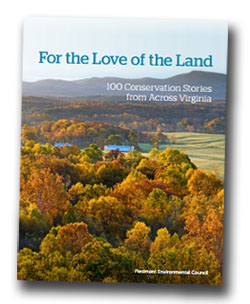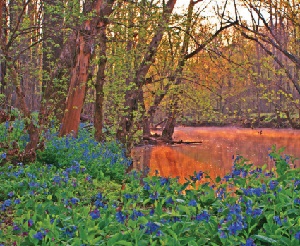 Land conservation is a Virginia tradition that goes back to the earliest days of the Commonwealth. Thomas Jefferson was so moved by the Natural Bridge he called it “the most sublime of nature’s works,” and he purchased 157 acres of the property in 1774. This honorable stewardship has continued into recent years. In an effort to preserve the land, the 90-foot-long limestone bridge was recently donated along with the sale of 1,500 acres to the Virginia Conservation Fund by its private owner. From the coast to the mountains, many landowners have been tending to their properties in Virginia for generations, carefully sustaining its resources and passing them on. In an effort to honor and highlight conservation efforts in our state, PEC has released For the Love of the Land: 100 Conservation Stories from Across Virginia.
Land conservation is a Virginia tradition that goes back to the earliest days of the Commonwealth. Thomas Jefferson was so moved by the Natural Bridge he called it “the most sublime of nature’s works,” and he purchased 157 acres of the property in 1774. This honorable stewardship has continued into recent years. In an effort to preserve the land, the 90-foot-long limestone bridge was recently donated along with the sale of 1,500 acres to the Virginia Conservation Fund by its private owner. From the coast to the mountains, many landowners have been tending to their properties in Virginia for generations, carefully sustaining its resources and passing them on. In an effort to honor and highlight conservation efforts in our state, PEC has released For the Love of the Land: 100 Conservation Stories from Across Virginia.
The book highlights the immense scope and diversity of conserved lands throughout the Commonwealth and the value they provide for all Virginians, from productive farmland to water quality to urban green space. The people involved, from all walks of life and from all over Virginia, may have different reasons for protecting their property, but what unites them is their love for the land and the need to protect it.

Ken and Ben Smith of Cool Lawn Farm
Photo by Rose Jenkins
One such conservation story tells of how a long-standing dream of owning an ice cream shop came true for a farmer in Fauquier County. Cool Lawn Farm was passed down to Ken Smith from his father, and he plans to hand over the dairy farm to his son, Ben. What started at 120 head of cattle on 200 acres has grown to almost 1,000 head on 2,000 acres.
Profit margins in the dairy business are a lot slimmer than they used to be, so Smith produces on a larger scale in order to provide a good life for his family. He has seen many dairy farms in Fauquier County shut down in his lifetime, so he knows that staying in business means adapting to change. However, there are things he doesn’t want to see change. He doesn’t want to see farmland give way to subdivisions and vanish like it has in Northern Virginia.
Smith decided to protect his farm through the Fauquier County Purchase of Development Rights program. In 2004 and 2006, he sold the development rights on two pieces of land, which totaled 469 acres. He used some of the money from selling his development rights to start a new farm-related business—an ice cream shop called Moo Thru, located on Rt. 29 in Remington.
Ben says it was his dad’s “20-year dream.” The ice cream shop gives people in Southern Fauquier County a place to come together and enjoy “an atmosphere of camaraderie,” said Smith. Moo Thru uses milk from grass-fed cows that graze their fields just a mile away. It also employs up to 30 people at a time. The major public benefits of this conserved land are productive farmland, water quality and scenic views.
For the Love of the Land also features properties with public access, such as Merrimac Farm, which was established as a state Wildlife Management Area in 2008. Throughout the year, visitors can enjoy hiking, wildlife viewing and fishing along more than a mile of frontage on Cedar Run in Prince William County. The farm offers vital wildlife habitat, including forested wetlands and vernal pools, some of the most threatened habitat types in the United States.

Merrimac Farm, a state Wildlife Management Area.
Photo by Ryan Wick
This protected land also helps ensure that suburban development will not interfere with the Marine Corps’ ability to train soldierson the adjacent Quantico Marine Base. Colonel Charles Dallachie said, “This partnership not only allows us to continue our mission of training Marines, but also lets the local community enjoy important Virginia habitat in its natural state.” The Prince William Conservation Alliance helped to secure funds for the Virginia Department of Game and Inland Fisheries (VDGIF) to purchase this property, from sources including VDGIF, Virginia Land Conservation Foundation and the U.S. Department of the Navy.
Historic preservation is another important element highlighted in For the Love of the Land. Holy Cross Abbey, a monastery in Berryville, decided to protect 205 acres by selling their development rights to the Clarke County Easement Authority in 2009. Additionally, The Civil War Trust purchased a tract of approximately 200 acres and transferred it to the Shenandoah University. The rolling fields are now a place of beauty and tranquility, but in 1864 they were filled with bloodshed when Confederate and Union forces fought in the Battle of Cool Spring. After exchanging deadly fire across the Shenandoah River, which runs along the property, the Confederates eventually drove the Union troops to retreat. Now, the history of this land can be preserved and the former battlefield protected.
However, the land holds even more than Civil War history. A total of 22 archeological sites from the prehistoric era to the 19th century occupy the grounds. Ancient artifacts from Native American inhabitants, dating as far back as 9,000 BC, were discovered on the monastery’s property. Holy Cross Abbey is currently moving forward on an easement to protect the remaining land, which would bring the total to approximately 1,000 acres.
The places featured in the book are protected in a variety of ways, through donated easements, purchased easements, public acquisition of land and gifts of land to the public. And the projects are supported by a number of sources such as federal, state, local and private funding. Whatever the means, the stewards that conserved the land have done a service to all Virginians. They have protected the essential resources we need for life—farmland to grow food, forests to provide wildlife habitat and wetlands to provide clean water. Their efforts will also keep alive the rich sense of history that sets Virginia apart from any other place.
To read more conservation stories, you can view the online map featuring the stories or the PDF version of the book.
This article was featured in our Winter 2014 Member Newsletter, The Piedmont View. You can read more of the articles online or view a PDF of the summer issue if you prefer.
